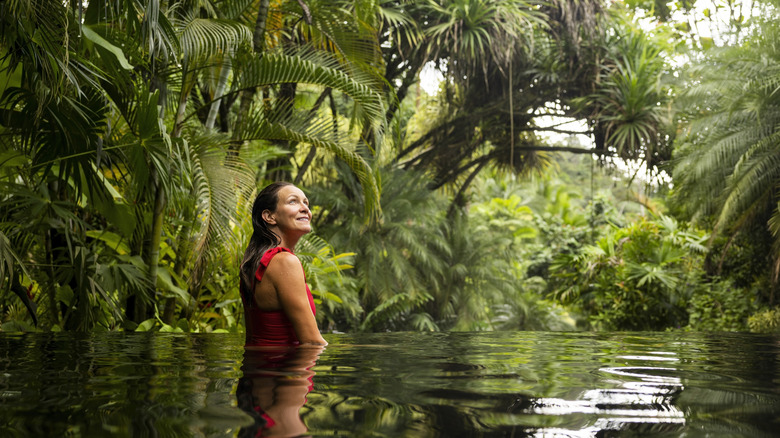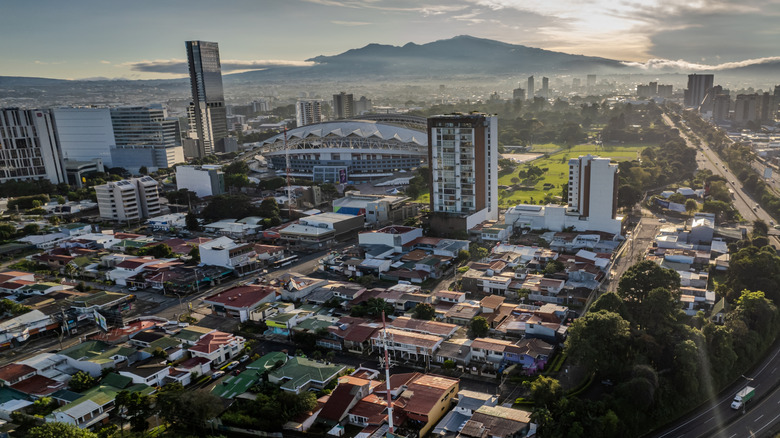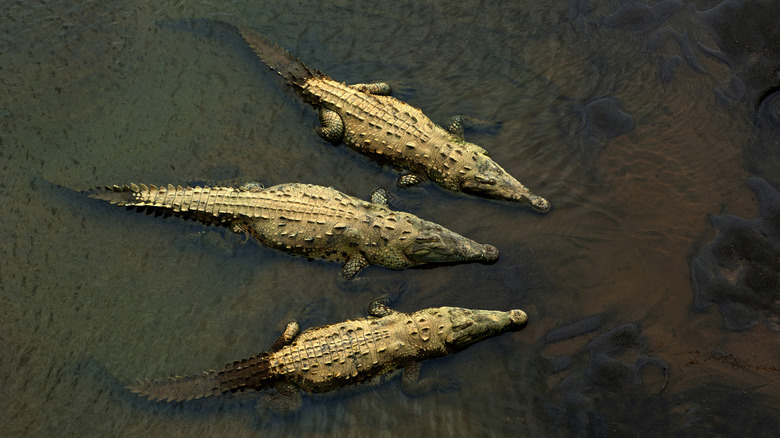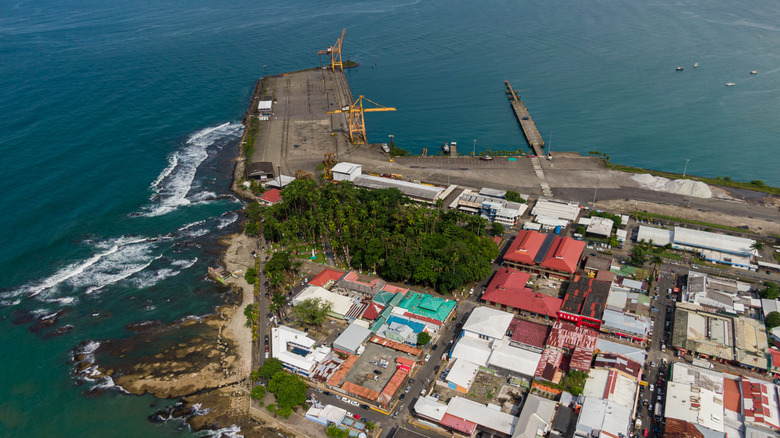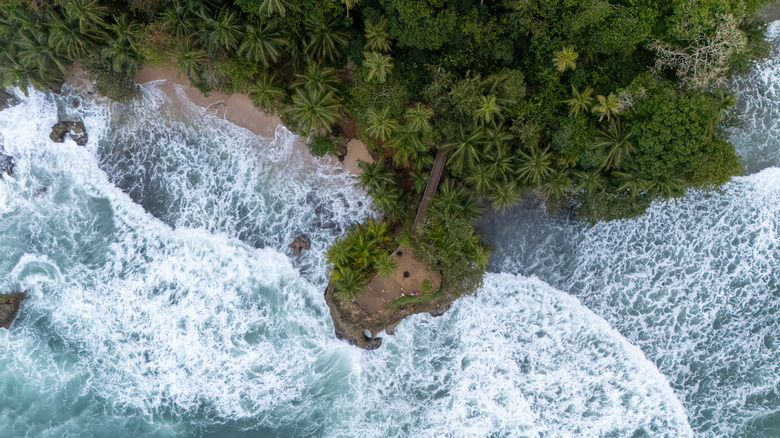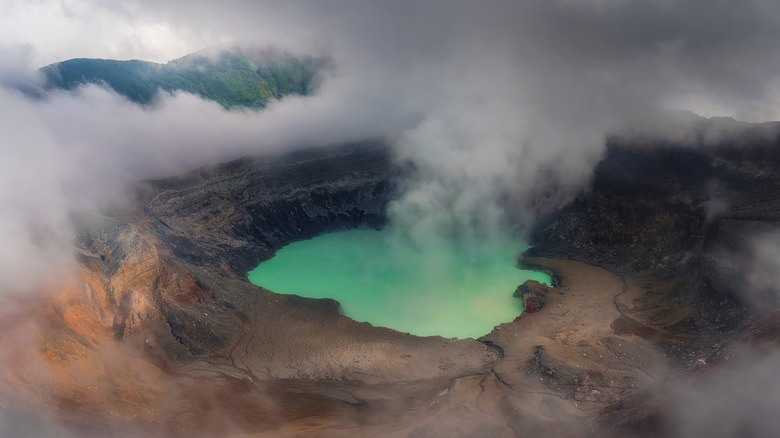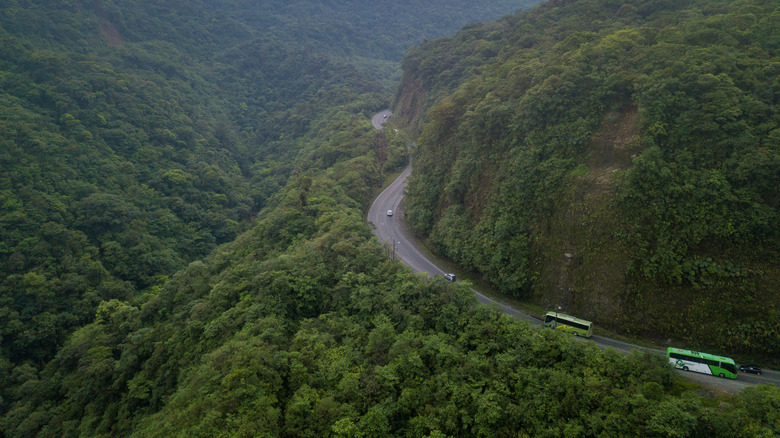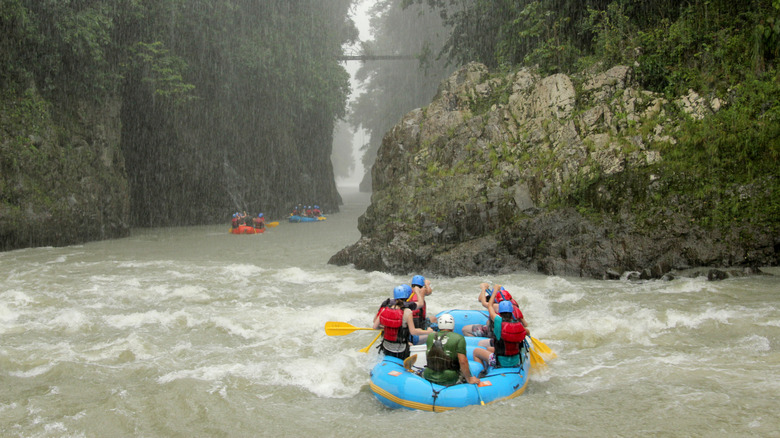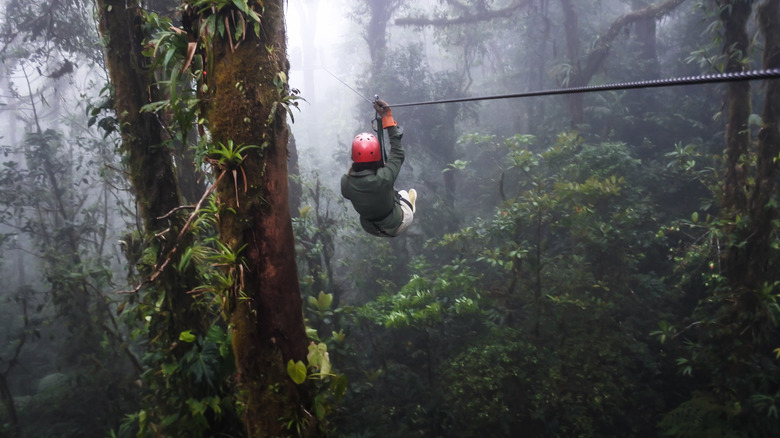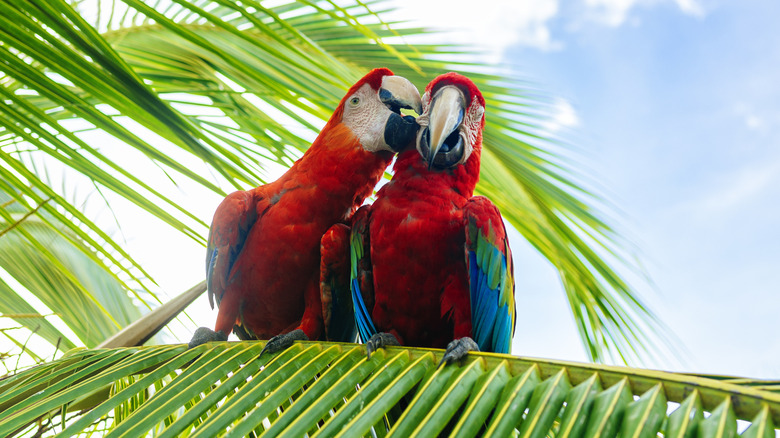The Most Dangerous Destinations In Costa Rica, According To Research
With forests shrouded in mist, steaming volcanoes towering over verdant valleys, monkeys swinging through canopies, and sloths casually hanging out to survey the scene, Costa Rica is a destination that has a little bit of everything. Over 800 miles of tropical shores wind along either the Caribbean or the Pacific, and there's adventure everywhere. You can raft on wild rivers or zip line over dense forests; in a country defined by Pura Vida (pure life), you'll never run out of activities. Costa Rica is also a place where you can slow down and relax with simple pleasures like natural hot springs and peaceful walks in nature. Throw in all the small-town communities and welcoming locals, and you have a place everyone should visit at least once.
However, is it dangerous? The short answer is no. Costa Rica ranks highly on the Global Peace Index — but nowhere is perfect. Opportunistic thieves target crowded tourist spots, and it's vital you lock up valuables in hotel safes and carry minimal cash, and don't even think about leaving anything in your vehicle. Thankfully, violent crime is rare, but that's not to say it doesn't happen, and there are places you absolutely should avoid or spend as little time in as possible.
The U.S. Department of State has set a Level 2 advisory warning for Costa Rica, which means travelers should exercise increased caution. This is the same level as France, Italy, and the United Kingdom, so it's no scarier than a trip to London or Paris. But it's not all about crime. Costa Rica has plenty other dangers to be aware of, and we've tried to cover everything you'll want to know before visiting. With all that in mind, here are the most dangerous destinations in Costa Rica and what you might encounter there.
San José
The Judicial Investigation agency (OIJ) states that the homicide rate in Costa Rica reached record-breaking numbers in 2023 (as reported by Cronkite News). The data indicate this is more than double the rate of 2006, with the OIJ linking most murders to drug trafficking. In San José, official figures show that there were 96 murders in 2024 (according to La Nación), which prompted the U.S. President to compare the crime rate in Washington, D.C., with that of the Costa Rican capital and other Latin American cities as justification for deploying the National Guard in the American capital. But the comparison drew objections in Costa Rica, where officials contend that security concerns in the city have been overblown.
Indeed, tourists are more likely to be targeted by petty crime. Pickpockets and bag snatchers are a problem, and precautions should be taken. Vehicle break-ins, burglary, and passport theft are other low-level crimes that also pose a risk. The Coca-Cola bus terminal is marked as a particular danger zone, as are sections of the downtown area. Mercado Central — a popular place for market stalls and food for both tourists and locals — and public parks are also considered risk zones.
Any adventurers straying away from these tourist hotspots in San José should reconsider areas with more problematic crime stats. If you are considering any of León XIII, Los Guido, Desamparados, or La Carpio for any reason, exercise a high level of caution. Additionally, the Santa Rita de Alajuela area to the northwest of the city near the airport is known as "El Infiernillo" (Little Hell) for a reason. There is very little need for tourists to venture into this area, but it is one to avoid at all costs due to drug- and gang-related activity.
Jacó, including the Tárcoles River 'Crocodile Bridge'
One of the first destinations you may well go to after San José is Jacó, and there are several dangers there to look out for. The first is a popular stop-off on the way — the bridge over the Río Tárcoles, aka "Crocodile Bridge." It's a popular spot where tourists excitedly snap pictures of dozens of American crocs basking in the sun below. However, don't get too close. A Nicaraguan man did in 2014 and met a particularly brutal demise that was witnessed by helpless onlookers, while another unidentified man perished that same year.
Dangerous reptiles aside, there are other problems in the area. For example, the sea around Jacó is infamous for its powerful waves and rip currents — a powerful, narrow flow of water that pulls out to sea. They are very dangerous, and if you are caught in one, rather than fight against it, you should maintain your composure and swim parallel to the beach until you are out of it. In 2023, a rip current claimed the life of a 45-year-old American swimming in the water at Jacó Beach.
Just south of Jacó at Playa Hermosa, powerful waves and currents claimed the life of a Canadian man in 2017, while just a couple of years before, a 2-year-old child and an elderly woman were also victims. Pay attention to the flags, especially when no lifeguards are present. Red means danger, yellow means exercise caution. If you're not confident, don't go out any further than waist-high. Jacó also poses a threat to visitors in terms of petty crime. According to the OIJ, there were 279 property crimes against tourists in 2023 (as reported by the Tico Times), including theft and robbery, so maintain the same caution you would in other cities.
Limón City
The province of Limón is home to some first-class tourist attractions, including Tortuguero and Cahuita National Parks, Gandoca-Manzanillo National Wildlife Refuge, and Puerto Viejo, with its stunning beaches and nightlife. The danger isn't in the province as a whole, but in the capital city, Puerto Limón. It's a city of around 65,000 inhabitants that tourists might use for transit, cruise port access, or maybe even an overnight stay if arriving late. Unfortunately, there is very little reason to hang about.
According to the Global Organized Crime Index, Costa Rica faces moderate levels of organized crime. However, the opening of Moín Port in Puerto Limón in 2019 has led to criminal organizations competing for control of the area to traffic cocaine. This has transformed the facility and surrounding areas into a hub of gang and trafficking-related activity, while economic hardships have led to scarce employment opportunities and increased poverty rates. As a result, much of the city's youth has been recruited into organized crime.
The city has the unwanted record of the highest murder rate in the country, accounting for 25% of all homicides in Costa Rica. In fact, Puerto Limón has triple the national average, and around 90% of local deaths are the result of clashes between rival gangs. The U.S. Department of the Treasury has imposed sanctions on drug traffickers working in the city who move cocaine and launder money through the port, with any assets they have in the U.S. frozen. It also blocks any business an American tries to do with them. In short, stay away from Puerto Limón or spend as little time there as possible if a visit is unavoidable.
Puerto Viejo de Talamanca
Puerto Viejo is a popular stop for travelers seeking palm-lined beaches, wildlife sanctuaries, and lively nightlife. Premier attractions include Playa Cocles, Punta Uva, the lush jungle of Cahuita National Park, and Gandoca-Manzanillo Wildlife Refuge for some protected nature on the coast. As tourist towns often attract unsavory characters anywhere in the world, there are, naturally, several safety factors you should be aware of. Statistics by Numbeo show crime is very much on the rise in the city, with petty crime and drugs a particular problem. Additionally, unlicensed taxis operate here, and it's advisable (especially for female travelers) to use only the licensed red or orange cabs. Dark streets at night also require precaution, as many are poorly lit or even completely blacked out. You should also seek local insights into which bars and nightclubs are generally considered safe, as there have been incidents.
Like the beaches at Jacó, Puerto Viejo is known for its dangerous rip currents. In an August 2025 post on X, formerly known as Twitter, the U.S. Department of State advised against swimming if there are no lifeguards on duty, and Puerto Viejo is one place where you should pay particular attention to this. The rip currents at Playa Cocles, just outside of town, can measure as strong as 9.1 feet per second. A good swimmer can only manage an average of around 5 feet per second, so the conditions there are deadly. In fact, on July 20, 2025, the actor Malcolm-Jamal Warner of "The Cosby Show" fame drowned at the age of 54 when he was pulled out to sea by a strong rip current at Playa Cocles. Puerto Viejo's natural beauty does come with real risks that demand respect, particularly if you want to enjoy the area's azure waters.
Poás Volcano
Located at an elevation of 8,884 feet (2,708 m) is a deep crater with a striking turquoise lake at its center. Volcán Poás, or Poás Volcano, belches out smoke plumes reaching up to the heavens, and it's one of Costa Rica's most famous. However, it is also one of the most hostile environments in the world. The year 2025 brought intense volcanic behavior, which started with minor eruptions in the early months. Activity escalated in March, which prompted authorities to close the park. Alert levels went through the whole traffic-light cycle, with the Costa Rican National Emergency Commission (CNE) issuing a red alert late in April. Explosive events launched ash 14,700 feet into the air along with heavy releases of toxic gas, while the area was classed as hazardous with unstable ground and volcanic rock projectiles.
However, the park closure didn't stop illegal tours from taking place. They visited restricted areas along unauthorized trails, and authorities have requested public help in combating them. Parque Nacional Volcán Poás has since reopened, but under a very strict set of rules. Tickets are available online only, and visits to the crater are limited to 20 minutes. Daily numbers are strictly controlled, and everyone must sign a waiver acknowledging the dangers, especially for noxious gases. However, 2025 wasn't the park's only recent disaster. In 2009, a magnitude 6.1 earthquake struck near the volcano, generating deadly landslides and claiming the lives of at least 23 people and injuring scores more. Visit at your own risk.
Route 32
The most dangerous road in Costa Rica is a 40-mile stretch from San José to Guápiles that passes directly through the lush Braulio Carrillo National Park. In this hair-raising section of Route 32, there is no proper drainage system or slope stabilization. This means there's a constant threat of landslides, particularly during the wet season. Storms often result in water cascading down onto the highway, and slow-moving trucks force drivers into dangerous overtaking maneuvers. The condition of the road has been described as "critical" by local media, and there are counterproductive laws at the heart of it. They prevent any infrastructure work within the park, which means no highway upgrade and no safety measures implemented.
The most vulnerable section is a 15-mile stretch between the Zurquí Tunnel and the Río Sucio within the park, and it's this area that is subject to serious landslides. In fact, there have been at least 30 recorded, with a third of them categorized as "very large." Thankfully, the conditions have not led to many fatalities, but an accident involving a tree falling onto the road caused the deaths of two people in 2020, while in 2021, a landslide caused a truck to overturn, with several people needing hospital treatment. In August 2025, the entire highway from San José to Limón was closed for 12 hours during heavy rain as a preventative measure.
Just outside the park, a major rehabilitation— including a four-lane expansion — is scheduled for completion in October 2025. For the problem section within the park, however, there has been no significant movement, although the National Concessions Council (CNC) is currently reviewing development proposals.
Río Pacuare
The Río Pacuare is the river that established Costa Rica as a world-class rafting destination. With year-round whitewater rafting set against lush jungle landscapes, it's an underrated adventure spot with unforgettable rapids. However, this wild waterway is fed by multiple tributaries that can trigger sudden changes in water levels, and there is no automated flow gauge. Calm sections can be transformed into hazardous rapids without warning, and tour operators rely entirely on rock markings and local expertise. For some tourists, it's this danger that adds to the river's allure. However, there have been too many occasions when things have gone horribly wrong.
In January 2000, two American tourists drowned after their raft capsized in flash-flood conditions. A few years later, a 19-year-old Canadian woman died after she was ejected from her raft and became wedged between rocks where rescuers could not get to her. And, more recently, in 2022, a Colombian woman was found dead after drowning while swimming, which highlights the fact that the river is just as dangerous beyond rafting tours.
It isn't only the Río Pacuare. If you're planning a whitewater rafting trip anywhere in Costa Rica, it pays to consider the dangers. In 2018, three rafts capsized on the Naranjo River, drowning four Americans and one Costa Rican guide. Survivors of this disaster noted that emergency responses were extremely slow, and the majority of the rescue effort was conducted by local bystanders. Elsewhere, a Canadian tourist fell from her raft in high water on the Sarapiquí River in 2015 and drowned. That particular incident was just one adventure-tourism fatality of six in Costa Rica that month. These accidents have highlighted poor safety regulations, with criticism directed at a lack of government inspections.
Monteverde Cloud Forest Reserve
Nestled high up in the Tilarán Range is Monteverde, a canton that has gained fame for its Cloud Forest Reserve — a tropical wonderland of rare orchids and vibrant beauty. With almost half of the country's flora and fauna (and around 2.5% of the entire world's), it's a wonderful destination that draws everyone from families to nature lovers from all over. Only 250 people can visit each day, so it's not a place where you have to battle for photos or join long queues. There are around 8 miles of trails to explore, and visitors can also enjoy elevated canopy walks, after-dark forest tours, hanging bridges, and some extreme zip-lining. In fact, it's said that this forest was the first place to offer zip-lining for recreational purposes, and it's really something that shouldn't be missed.
So, where's the danger? Well, the truth is, it actually is a spectacular place to visit. Just don't come in the wet season. In 2024, rains triggered by the Central American Gyre — a seasonal low-pressure weather system — caused flooding that blocked roads and caused damage to multiple homes. Some people ended up stranded and had to be rescued, while rivers overflowed, landslides buried roads, and infrastructure and property suffered serious damage.
It wasn't the first time the heavens inflicted so much devastation, either. Just seven years prior, Tropical Storm Nate dumped 25 inches of water on the Monteverde area in just a few days. The area had already been experiencing severe weather, and Nate ensured the situation reached crisis levels. Landslides blocked access routes, creeks turned into raging rivers, and an upstream dam threatened to burst in what were some very precarious moments. If you visit Monteverde Cloud Forest Reserve in the wet season, bring an umbrella.
Methodology
As Costa Rica is generally considered a safe country, we decided to only include the places with the absolute highest crime rates and potential dangers. For the rest, we wanted to inform readers about other real dangers. We scoured news reports, government alerts, travel advisories, and tourism resources to find these dangers and focused on locations with documented incidents that have affected visitors, including crime, natural hazards, and accidents.
